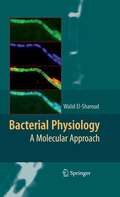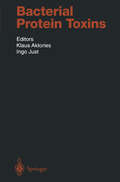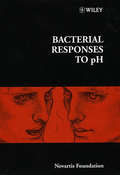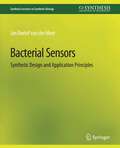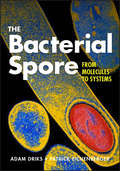- Table View
- List View
Bacterial Persistence: Methods and Protocols (Methods in Molecular Biology #2357)
by Jan Michiels Natalie VerstraetenThis volume presents a collection of methods that have contributed to the current understanding of bacterial persisters. Chapters in the book detail general guidelines for measuring persister levels in bacterial cultures, strategies to enrich and resuscitate persister subpopulations, single-cell approaches for visualizing and characterizing persisters, omics techniques and cellular and animal models for studying persistence. Written in the highly successful Methods in Molecular Biology series format, chapters include introductions to their respective topics, lists of the necessary materials and reagents, step-by-step, readily reproducible laboratory protocols, and tips on troubleshooting and avoiding known pitfalls. Authoritative and cutting-edge, Bacterial Persistence: Methods and Protocols, Second Edition aims to be a useful practical guide to researchers to help further their study in this field.
Bacterial, Phage and Molecular Genetics: An Experimental Course
by U. Winkler W. Rüger W. WackernagelBacterial Physiology: A Molecular Approach
by Walid El-SharoudThe application of new molecular methodologies in the study of bacterial behavior and cell architecture has enabled new revolutionary insights and discoveries in these areas. This new text presents recent developments in bacterial physiology that are highly relevant to a wide range of readership including those interested in basic and applied knowledge. Its chapters are written by international scientific authorities at the forefront of the subject. The value of this recent knowledge in bacterial physiology is not only restricted to fundamental biology. It also extends to biotechnology and drug-discovery disciplines.
Bacterial Pili: Structure, Synthesis and Role in Disease (Advances in Molecular and Cellular Microbiology #27)
by Michèle A. Barocchi John L. TelfordBacterial pili play important roles as environmental sensors, in host colonization and in biofilm formation, enabling bacteria to interact with the environment, with surfaces and with other bacteria and host cells. Most bacteria, both Gram positive and Gram negative, and almost all bacterial pathogens, are piliated. This book discusses the synthesis, structure, evolution, function and role in pathogenesis of these complex structures, and their basis for vaccine development and therapeutics for Streptococcus pathogens. It is an invaluable resource for researchers and students of medical microbiology.
Bacterial Polysaccharides: Methods and Protocols (Methods in Molecular Biology #1954)
by Inka BrockhausenThis book provides a selection of recently developed methods and protocols in bacterial glycomics to aid in bettering our understanding of the structures and functions of bacterial polysaccharides, their attachments to proteins and lipids, their role in biofilm formation, as well as their biosynthesis. With the emerging bacterial resistance to commonly used antibiotics world-wide, these techniques to study the outer polysaccharides of bacteria, with their functions in bacterial adhesion, colonization, growth, establishment of biofilms, and control virulence and pathogenicity, are increasingly important. Written for the highly successful Methods in Molecular Biology series, chapters include introductions to their respective topics, lists of the necessary materials and reagents, step-by-step, readily reproducible laboratory protocols, and tips on troubleshooting and avoiding known pitfalls. Authoritative and cutting-edge, Bacterial Polysaccharides: Methods and Protocols aims to support researchers contributing to future approaches that will fill our knowledge gaps and define anti-bacterial targets.
Bacterial Population Genetics in Infectious Disease
by D. Ashley Robinson Edward J. Feil Daniel FalushThis book is a unique synthesis of the major concepts and methods in bacterial population genetics in infectious disease, a field that is now about 35 yrs old. Emphasis is given to explaining population-level processes that shape genetic variation in bacterial populations and statistical methods of analysis of bacterial genetic data. A "how to" of bacterial population genetics, which covers an extremely large range of organisms Expanding area of science due to high-throughput genome sequencing of bacterial pathogens Covers both fundamental approaches to analyzing bacterial population structures with conceptual background in bacterial population biology Detailed treatment of statistical methods
Bacterial Protein Secretion Systems: Methods and Protocols (Methods in Molecular Biology #1615)
by Laure Journet Eric CascalesThis volume details protocols that cover the broad arsenal of techniques used to study a secretion system from A to Z. Chapters focus on identifying and localizing the different subunits, defining interactions within subunits, monitoring conformational changes, purifying and imaging of large complexes, defining the assembly pathway by fluorescence microscopy and the role of energy during assembly and/or secretion, identifying secreted effectors as well as reporters to follow effector transport. Written in the highly successful Methods in Molecular Biology series format, chapters include introductions to their respective topics, lists of the necessary materials and reagents, step-by-step, readily reproducible laboratory protocols, and tips on troubleshooting and avoiding known pitfalls.Authoritative and cutting-edge, Bacterial Protein Secretion Systems: Methods and Protocol aims to provide techniques that are not restricted to the study of secretion systems but are also of specific interest for any researcher interested on multi-protein complexes of the bacterial cell envelope.
Bacterial Protein Toxins (Handbook of Experimental Pharmacology #145)
by K. Aktories I. JustIn recent years remarkable progress has been accomplished with respect to our knowledge about bacterial protein toxins. This refers especially to structural aspects of protein toxins but also holds true for genetics, molecular biology and biochemical mechanisms underlying the action of toxins. This volume covers the very current and exciting aspects of up-to-date bacterial toxicology and comprehensively reviews the most important bacterial protein toxins such as the intracellular acting toxins which exhibit enzyme activity, as well as those toxins that interact with cell plasma membranes by damaging the membranes (pore formation) or stimulating cell receptors (superantigens). This is the most current reference work on these important bacterial protein toxins, which are presented from the point of view of different disciplines such as pharmacology, microbiology, cell biology and protein chemistry.
Bacterial Regulatory RNA: Methods and Protocols (Methods in Molecular Biology #1737)
by Véronique Arluison Claudio ValverdeThis volume details the most important methods used for studying prokaryotic non-coding RNAs and their protein accomplices. Chapters present methods in sections covering different aspects of the biology of that field: identification of ncRNAs, their differential expression, characterization of their structure, abundance, intracellular location and function, their interaction with RNA binding proteins, and plausible applications of ncRNA elements in the rapidly emerging field of synthetic biology. Written in the highly successful Methods in Molecular Biology series format, chapters include introductions to their respective topics, lists of the necessary materials and reagents, step-by-step, readily reproducible laboratory protocols, and tips on troubleshooting and avoiding known pitfalls. Authoritative and cutting-edge, Bacterial Regulatory RNA: Methods and Protocols serves as a guidebook for scientists working toward the development of new tools and procedures for the vital field of sRNA biology.
Bacterial Regulatory RNA: Methods and Protocols (Methods in Molecular Biology #2741)
by Véronique Arluison Claudio ValverdeThis second edition details new and updated methods used for studying prokaryotic non-coding RNAs and their protein accomplices. Chapters detail discovery of ncRNAs, characterization of their structure, functions, and their interactomes. Written in the highly successful Methods in Molecular Biology series format, chapters include introductions to their respective topics, lists of the necessary materials and reagents, step-by-step, readily reproducible laboratory protocols, and tips on troubleshooting and avoiding known pitfalls. Authoritative and cutting-edge, Bacterial Regulatory RNA: Methods and Protocols, Second Edition aims to ensure successful results in the further study of this vital field.
Bacterial Regulatory RNA: Methods and Protocols (Methods in Molecular Biology #905)
by Kenneth C. KeilerThe discovery of wide-spread RNA-based regulation in bacteria has led to new evaluations of the importance of bacterial regulatory RNA in every aspect of bacterial physiology. In Bacteria Regulatory RNA: Methods and Protocols, expert researchers in the field detail many of the methods which are now commonly used to study bacterial regulatory RNA. These include methods and techniques to identify regulatory RNAs, characterizing the function and expression of regulatory RNAs in bacterial cells, RNA structure prediction, and interactions between regulatory RNAs and proteins. Written in the highly successful Methods in Molecular Biology™ series format, chapters include introductions to their respective topics, lists of the necessary materials and reagents, step-by-step, readily reproducible laboratory protocols, and key tips on troubleshooting and avoiding known pitfalls. Authoritative and practical, Bacteria Regulatory RNA: Methods and Protocols seeks to aid scientists in the further study of bacterial regulatory RNA.
Bacterial Resistance to Antibiotics: From Molecules to Man
by Boyan B. Bonev Nicholas M. BrownAN AUTHORITATIVE SURVEY OF CURRENT RESEARCH INTO CLINICALLY USEFUL CONVENTIONAL AND NONCONVENTIONAL ANTIBIOTIC THERAPEUTICS Pharmaceutically-active antibiotics revolutionized the treatment of infectious diseases, leading to decreased mortality and increased life expectancy. However, recent years have seen an alarming rise in the number and frequency of antibiotic-resistant "Superbugs." The Centers for Disease Control and Prevention (CDC) estimates that over two million antibiotic-resistant infections occur in the United States annually, resulting in approximately 23,000 deaths. Despite the danger to public health, a minimal number of new antibiotic drugs are currently in development or in clinical trials by major pharmaceutical companies. To prevent reverting back to the pre-antibiotic era—when diseases caused by parasites or infections were virtually untreatable and frequently resulted in death—new and innovative approaches are needed to combat the increasing resistance of pathogenic bacteria to antibiotics. Bacterial Resistance to Antibiotics – From Molecules to Man examines the current state and future direction of research into developing clinically-useful next-generation novel antibiotics. An internationally-recognized team of experts cover topics including glycopeptide antibiotic resistance, anti-tuberculosis agents, anti-virulence therapies, tetracyclines, the molecular and structural determinants of resistance, and more. Presents a multidisciplinary approach for the optimization of novel antibiotics for maximum potency, minimal toxicity, and appropriated degradability Highlights critical aspects that may relieve the problematic medical situation of antibiotic resistance Includes an overview of the genetic and molecular mechanisms of antibiotic resistance Addresses contemporary issues of global public health and longevity Includes full references, author remarks, and color illustrations, graphs, and charts Bacterial Resistance to Antibiotics – From Molecules to Man is a valuable source of up-to-date information for medical practitioners, researchers, academics, and professionals in public health, pharmaceuticals, microbiology, and related fields.
Bacterial Resistance to Antibiotics: From Molecules to Man
by Boyan B. Bonev Nicholas M. BrownAN AUTHORITATIVE SURVEY OF CURRENT RESEARCH INTO CLINICALLY USEFUL CONVENTIONAL AND NONCONVENTIONAL ANTIBIOTIC THERAPEUTICS Pharmaceutically-active antibiotics revolutionized the treatment of infectious diseases, leading to decreased mortality and increased life expectancy. However, recent years have seen an alarming rise in the number and frequency of antibiotic-resistant "Superbugs." The Centers for Disease Control and Prevention (CDC) estimates that over two million antibiotic-resistant infections occur in the United States annually, resulting in approximately 23,000 deaths. Despite the danger to public health, a minimal number of new antibiotic drugs are currently in development or in clinical trials by major pharmaceutical companies. To prevent reverting back to the pre-antibiotic era—when diseases caused by parasites or infections were virtually untreatable and frequently resulted in death—new and innovative approaches are needed to combat the increasing resistance of pathogenic bacteria to antibiotics. Bacterial Resistance to Antibiotics – From Molecules to Man examines the current state and future direction of research into developing clinically-useful next-generation novel antibiotics. An internationally-recognized team of experts cover topics including glycopeptide antibiotic resistance, anti-tuberculosis agents, anti-virulence therapies, tetracyclines, the molecular and structural determinants of resistance, and more. Presents a multidisciplinary approach for the optimization of novel antibiotics for maximum potency, minimal toxicity, and appropriated degradability Highlights critical aspects that may relieve the problematic medical situation of antibiotic resistance Includes an overview of the genetic and molecular mechanisms of antibiotic resistance Addresses contemporary issues of global public health and longevity Includes full references, author remarks, and color illustrations, graphs, and charts Bacterial Resistance to Antibiotics – From Molecules to Man is a valuable source of up-to-date information for medical practitioners, researchers, academics, and professionals in public health, pharmaceuticals, microbiology, and related fields.
Bacterial Responses to pH (Novartis Foundation Symposia #221)
by Gail Cardew Derek J. ChadwickMicrobial responses to acidic and alkaline pH are important in many areas of bacteriology. For example, the mechanisms of resistance to acidic pH are important in the understanding of the passage of human pathogens through the acid of the stomach; and an understanding of microbial degradation of alkaline industrial waste is important for the environment. Bringing together contributions from an international and interdisciplinary group of experts working on the many aspects of bacterial cellular responses to pH, this stimulating volume draws together new and innovative work in this area. It delineates both similarities and differences between mechanisms of tolerance and response, providing readers with an invaluable resource on the subject.
Bacterial Secretion Systems: Methods and Protocols (Methods in Molecular Biology #2715)
by Laure Journet Eric CascalesThis second edition details new and updated protocols that cover techniques used to study secretion systems. Chapters focus on identifying and localizing the different subunits, defining interactions within subunits, monitoring conformational changes, purifying and imaging of large complexes, defining the assembly pathway by fluorescence microscopy and the role of energy during assembly and/or secretion, identifying secreted effectors as well as using reporters to follow effector transport. Written in the highly successful Methods in Molecular Biology series format, chapters include introductions to their respective topics, lists of the necessary materials and reagents, step-by-step, readily reproducible laboratory protocols, and key tips on troubleshooting and avoiding known pitfalls. Authoritative and cutting-edge, Bacterial Secretion Systems: Methods and Protocols- Second Edition aims to be a useful and practical guide to new researchers and experts looking to expand their knowledge.
Bacterial Sensors: Synthetic Design and Application Principles (Synthesis Lectures on Synthetic Biology)
by Jan Roelof MeerBacterial reporters are live, genetically engineered cells with promising application in bioanalytics. They contain genetic circuitry to produce a cellular sensing element, which detects the target compound and relays the detection to specific synthesis of so-called reporter proteins (the presence or activity of which is easy to quantify). Bioassays with bacterial reporters are a useful complement to chemical analytics because they measure biological responses rather than total chemical concentrations. Simple bacterial reporter assays may also replace more costly chemical methods as a first line sample analysis technique. Recent promising developments integrate bacterial reporter cells with microsystems to produce bacterial biosensors. This lecture presents an in-depth treatment of the synthetic biological design principles of bacterial reporters, the engineering of which started as simple recombinant DNA puzzles, but has now become a more rational approach of choosing and combining sensing, controlling and reporting DNA 'parts'. Several examples of existing bacterial reporter designs and their genetic circuitry will be illustrated. Besides the design principles, the lecture also focuses on the application principles of bacterial reporter assays. A variety of assay formats will be illustrated, and principles of quantification will be dealt with. In addition to this discussion, substantial reference material is supplied in various Annexes. Table of Contents: Short History of the use of Bacteria for Biosensing and Bioreporting / Genetic Engineering Concepts / Measuring with Bioreporters / Epilogue
Bacterial Signal Transduction: Networks And Drug Targets (pdf) (Advances in Experimental Medicine and Biology #631)
by Ryutaro UtsumiBacterial Signaling
by Reinhard Krämer Kirsten JungProviding a comprehensive insight into cellular signaling processes in bacteria with a special focus on biotechnological implications, this is the first book to cover intercellular as well as intracellular signaling and its relevance for biofilm formation, host pathogen interactions, symbiotic relationships, and photo- and chemotaxis. In addition, it deals in detail with principal bacterial signaling mechanisms -- making this a valuable resource for all advanced students in microbiology. Dr. Kramer is a world-renowned expert in intracellular signaling and its implications for biotechnology processes, while Dr. Jung is an expert on intercellular signaling and its relevance for biomedicine and agriculture.
The Bacterial Spore: From Molecules to Systems (ASM Books)
by Adam Driks Patrick EichenbergerThe study of bacterial spores spans biosecurity to ecology The first articles describing the sporulation process were published by Robert Koch and Ferdinand Cohn in the late 19th century. Although most of the work accomplished in the past 50 years has focused on the model organism Bacillus subtilis, more recent work significantly expanded the scope of sporulation research to integrate medically relevant spore pathogens, such as B. anthracis and Clostridium difficile, as well as investigations of the ecology of spore-forming species. This new direction is supported by an explosion of novel techniques that can also be applied to nonmodel organisms, such as next-generation sequencing, metagenomics, and transcriptomics. The Bacterial Spore provides a comprehensive series of reviews of the major topics in spore biology that represent intensive, cutting-edge spore research. Editors Adam Driks and Patrick Eichenberger assembled chapters written by a team of diverse and multidisciplinary experts in biodefense and microbial forensics to produce an overview of topics of spore research, such as spore molecular biology, bioremediation, systems biology, issues in biodefense, and the challenge of food safety that is accessible to any reader, regardless of expertise. The Bacterial Spore also encompasses the diversity of spore research, which will appeal to those seeking to broaden their knowledge. The Bacterial Spore is a reference for a wide range of readers, including geneticists, cell biologists, physiologists, structural and evolutionary biologists, applied scientists, advanced undergraduate and graduate students, and nonresearchers, such as national security professionals.
The Bacterial Spore: From Molecules to Systems (ASM Books)
by Adam Driks Patrick EichenbergerThe study of bacterial spores spans biosecurity to ecology The first articles describing the sporulation process were published by Robert Koch and Ferdinand Cohn in the late 19th century. Although most of the work accomplished in the past 50 years has focused on the model organism Bacillus subtilis, more recent work significantly expanded the scope of sporulation research to integrate medically relevant spore pathogens, such as B. anthracis and Clostridium difficile, as well as investigations of the ecology of spore-forming species. This new direction is supported by an explosion of novel techniques that can also be applied to nonmodel organisms, such as next-generation sequencing, metagenomics, and transcriptomics. The Bacterial Spore provides a comprehensive series of reviews of the major topics in spore biology that represent intensive, cutting-edge spore research. Editors Adam Driks and Patrick Eichenberger assembled chapters written by a team of diverse and multidisciplinary experts in biodefense and microbial forensics to produce an overview of topics of spore research, such as spore molecular biology, bioremediation, systems biology, issues in biodefense, and the challenge of food safety that is accessible to any reader, regardless of expertise. The Bacterial Spore also encompasses the diversity of spore research, which will appeal to those seeking to broaden their knowledge. The Bacterial Spore is a reference for a wide range of readers, including geneticists, cell biologists, physiologists, structural and evolutionary biologists, applied scientists, advanced undergraduate and graduate students, and nonresearchers, such as national security professionals.
Bacterial Systematics
by N. A. LoganThis is the first book on bacterial systematics at the undergraduate level. The first part explains why bacteria are classified and how they are named. It also covers the practice of classification, including evolutionary studies and identification. The applications of these methods are illustrated in the second part of the book, which describes progress in the classification and identification of the spirochaetes, helical and curved bacteria, Gram-negative aerobic, facultative and strictly anaerobic bacteria, Gram-positive cocci, rods and endospore formers, mycoplasmas, and actinomycetes, and outlines the importance of these organisms. The first book on this topic at undergraduate level Includes evolutionary studies and the Archaea Covers theory and practice of bacterial classification and identification User-friendly style and profuse illustrations
Bacterial Therapy of Cancer: Methods and Protocols (Methods in Molecular Biology #1409)
by Robert M. HoffmanThis volume explores the evolution of bacterial cancer therapy and describes the modern techniques used in therapy today. The chapters in this book cover a broad range of topics such as the development of tumor-targeting Salmonella typhimurium A1-R, a microfluidic device for precise quantification of the interactions between tumor-targeting bacteria and tumor tissue, non-invasive in vivo imaging of bacteria-mediated cancer therapy using bio-luminescent bacteria, methods to achieve remote-control of therapeutic gene expression in tumor-targeting bacteria, and cell-cycle decoy of cancer cells resistant to cytotoxic drugs to drug sensitivity by S. typhimurium A1-R. This book concludes with a chapter on the future potential of bacterial therapy of cancer. Written in the highly successful Methods in Molecular Biology series format, chapters include introductions to their respective topics, lists of the necessary materials and reagents, step-by-step, readily reproducible laboratory protocols, and tips on troubleshooting and avoiding known pitfalls.Thorough and informative, Bacterial Therapy of Cancer: Methods and Protocols is a valuable resource for anyone who is interested in cancer and bacterial therapy.
Bacterial Toxins: Tools in Cell Biology and Pharmacology
by Klaus AktoriesThis is a survey of well characterized and recently discovered bacterial protein toxins. Leading investigators of the respective toxins review the various molecular mechanisms of action, ranging from toxin-induced ADP-ribosylation up to membrane perforation by pore-forming toxins. Thy also describe the consequences on host physiology before focusing on potential applications as cell biological and pharmacological tools for research and medical applications. Detailed descriptions of the methodology include the engineering and use of modified and chimeric toxins for better performance. A solid introduction to toxin structure and functions, as well as a valuable source of methodology for researchers in molecular biology, pharmacology and experimental medicine.
Bacterial Toxins: Methods and Protocols (Methods in Molecular Biology #145)
by Otto HolstThe interest of investigators across a broad spectrum of scientific dis- plines has been steadily stimulated by the field of bacterial toxin research, an area that makes use of a large variety of biological, chemical, physicochemical, and medically oriented approaches. Researchers studying bacterial toxins need to be acquainted with all these disciplines in order to work effectively in the field. To date, there has been no published collection offering detailed descr- tions of the techniques and methods needed by researchers operating across the field’sdiverse areas. The present volume Bacterial Toxins: Methods and Pro- cols, is intended to fill this gap. Bacterial Toxins: Methods and Protocols consists of two sections: one on protein toxins (15 chapters) and one on endotoxins (5 chapters). Each s- tion is introduced by an overview article (Chapters 1 and 16). The protocols collected represent state-of-the-art techniques that each have high impact on future bacterial toxin research. All methods are described by authors who have regularly been using the protocol in their own laboratories. Included in each chapter is a brief introduction to the method being described.
Bacterial Transcriptional Control: Methods and Protocols (Methods in Molecular Biology #1276)
by Irina Artsimovitch and Thomas J. SantangeloThis volume is designed to be a resource of proven techniques and approaches for probing the activities of bacterial, eukaryotic, and archaeal RNA polymerases. This book features a collection of in vitro and in vivo technologies that will permit researchers to purify and probe the position and stability of RNA polymerase complexes at different points of the transcription cycle, analyze the various translocations and intermolecular movements associated with catalysis, define recruitment strategies, probe the roles of transcription factors in each stage of the cycle, highlight conserved and disparate fidelity mechanisms, analyze the resultant transcripts, and study coordination of the nascent mRNA synthesis by the RNA polymerase and mRNA translation by the ribosome. Written in the highly successful Methods of Molecular Biology series format, chapters include introductions to their respective topics, lists of the necessary materials and reagents, step-by-step, readily reproducible laboratory protocols, and key tips on troubles troubleshooting and avoiding known pitfalls. Practical and timely, Bacterial Transcriptional Controls: Methods and Protocols highlights the breadth and depth of techniques that are likely to continue shaping the transcription community in the future.


